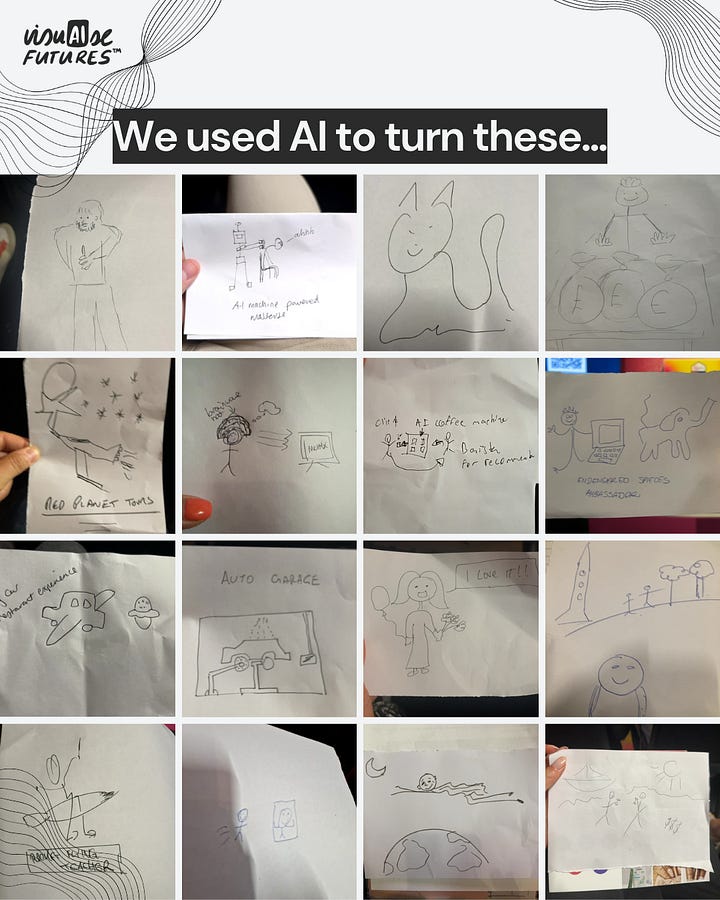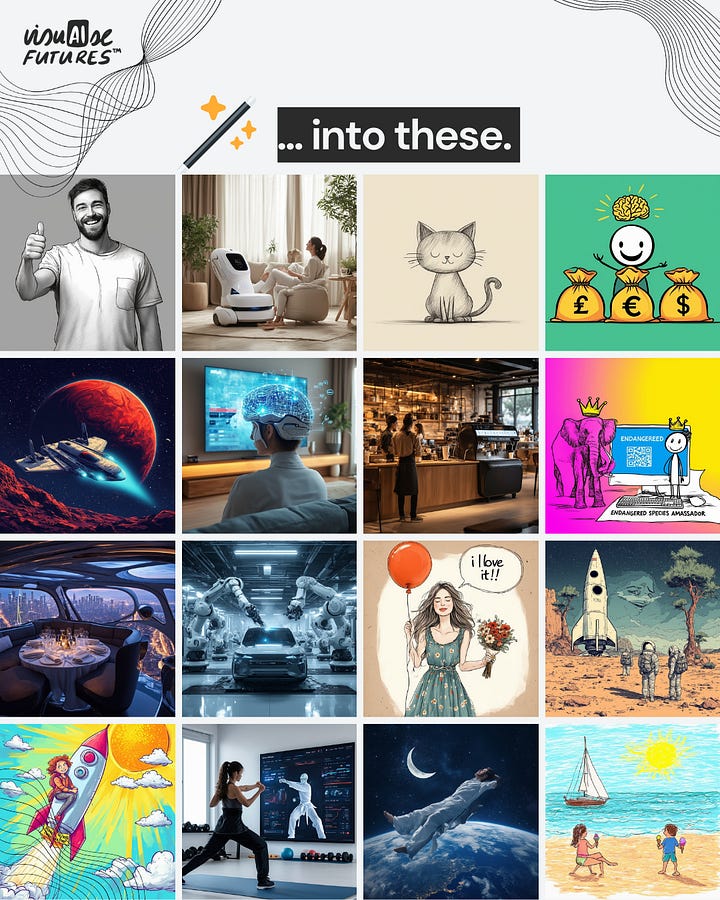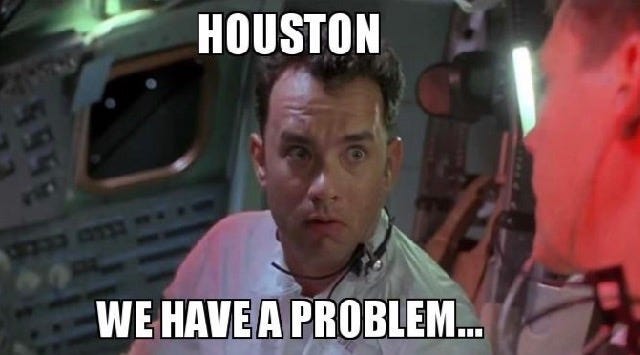What's going on with AI? 🫧
Plus insights from launching a new AI event experience of my own.
There’s been a lot of talk recently about the bursting of the AI bubble. Now, I’m not especially interested in the financial returns from AI – what interests me is if it will be a transformative technology for people, organisations and society.
In other words – will it change your career and your life? And if so, how?
Answering this question is hard because we don’t know. Indeed, we won’t ever fully ‘know’ AI’s real-world capabilities and implications until it gets deployed successfully.
This is why I call myself a ‘reluctant futurist’ – it is today’s innovations that create tomorrow’s expectations. And expectations are everything when it comes to understanding where things are headed.
Which is why I was so struck by a recent Upwork study on the different views that C-suite leaders and employees have when it comes to AI.
The AI expectation gap
Upwork reports that:
“96% of C-suite leaders say they expect the use of AI tools to increase their company’s overall productivity levels.”
Vs.
“77% of employees say these tools have actually decreased their productivity and added to their workload.”
This is an astonishing gap. It’s also a deeply painful gap that will only lead to conflict, resentment and disillusionment.
Side note: I suspect this gap is not only true at an organisational level. You probably feel something similar. If you’re anything like me, you feel that you should be more productive thanks to AI. But then you try to use AI in your work and end up feeling like it has slowed you down. It’s often deeply frustrating.
However when it ‘works’, you can see how powerful AI can be, as I’ll show below.
New technologies, old mindsets
It’s hardly surprising that we see many disappointing results from AI – we’re not using it effectively.
It’s the same with every new technology. We rush to apply it within our existing systems:
Early industrial factories simply replaced steam engines with centralised electric motors, to limited effect.
Early e-commerce websites simply replicated static print brochures, digitally.
Early mobile sites were copies of their desktop predecessors.
In each instance, it took time before people reconfigured their operations and business models around the new technologies:
Henry Ford created the modern production line.
Jeff Bezos created ‘the everything store’.
Mark Zuckerberg brought together a suite of mobile-first social platforms and tools.
We’re following the same pattern when it comes to generative AI. We've been so conditioned by 40+ years of experiencing computers as relentlessly precise calculating machines that we expect generative AI to do what computers have always done: help us do more, faster and cheaper.
My experiences over the last 6 months are leading me to a profoundly different conclusion.
What if AI isn’t ‘efficient’?
Read many of the McKinsey or BCG reports on Gen AI and you’ll read all about the benefits from AI. Cost savings! Automation! Efficiency!
We can all understand why this is story so compelling. But it doesn’t seem to be the reality for the hundreds of millions of white-collar workers who use computers in their professional lives1.
After 18 months of relentless hype and widespread experimentation, most people’s days haven’t been transformed by AI – less than 10% of people use ChatGPT daily (compare this with smartphones!)2.
You already know why. Its outputs are too generic. They are too inconsistent and unreliable. We don’t yet know if these issues can be resolved.
However, instead of trying to force the square pegs that are LLMs into the round hole of efficiency, what if we looked for different, square-shaped holes that LLMs will fit better into?
What if we looked for use cases where its impreciseness and unpredictability are features, rather than bugs?
Augmented Creativity
Less than 1% of the words you’re reading were generated by AI. Physically writing these words (and the 100s of half-written-but-quickly-deleted tangents) is how I arrive at the insights you’re reading.
However while I have no plans to outsource my writing to AI, I used it throughout the creation of this piece.
I dropped my early quick ideas into ChatGPT. Reading its replies sparked new thoughts (indeed, I usually try to avoid its suggestions and find the deeper, ‘non-obvious’ insights). I asked Perplexity to find statistics and alternative examples. Its sources reminded me of other articles I’ve read. I turned to Claude to review and critique the draft article. It found a few sections to tighten.
AI is a wonderful creative copilot. Indeed, I couldn’t imagine not using it while working – even though I don’t want it to do my work.
Which brings me to the experience of building my own creative AI tool, VisuAIse Futures, and why I remain so bullish on the prospects for this technology – when used for the right tasks.
VisuAIse Futures: a multiplayer, AI-powered event experience
I go deep into the backstory below because I think it says a lot about how and where to use AI. But you can just watch the video above to see the new ‘multiplayer’, collaborative AI-powered event experience we’ve built.
The Q3/4 event ‘season’ is filling up – from September I’ll be taking VisuAIse Futures (and my usual trend sessions) to Berlin, New York, Las Vegas, Rome, Greece, Barcelona and Riyadh, as well as staying closer to home in London, Bournemouth and Berkshire :)
If you’d like to move from booking yet another talk about AI, to giving your audience a visceral, memorable, and downright fun experience with AI – then please do DM me or Renee Strom on renee@ideapress-speakers.com.
A few months ago I was having dinner with a client I’ve worked with on big events in Las Vegas. He made a comment that traditional keynotes weren’t enough in the post-pandemic era. If people were going to get on a plane and come to an event, they wanted an immersive, shared experience.
I’d been working with the visual strategist Natalia Talkowska to create a series of illustrated guides to AI innovation opportunities, and his comment got me thinking:
What if we could use AI to turn a trend keynote into a meaningful shared experience?
What if we could let people doodle their visions of the future (very roughly, in 1-minute, with pens and paper)?
What if we could then ask them to take out their phones, snap a photo, and in seconds use AI to turn their quick sketches into infinitely richer, ‘better’ images?
What if we could then show all these images on a big screen – live and together?
What if we could then use AI to analyse these hundreds of images – teasing out key common themes and highlighting areas of alignment?
Caught up in the moment of inspiration, I whipped out my phone and tested it using ChatGPT. It worked!
But while it worked on my phone, my vision was to make this a shared experience – to use AI to bring an audience together in a way that people would never forget.
Three years ago, the idea that I could build a web app would be terrifying. I spent 10 years running an online content business, and my experience with developers went along the classic lines of “fast, good or cheap – pick two”.
Yet I’d recently done a workshop where Bradley Stacey, the Head of AI at MISSION Group, closed his session by saying, “if you’re sitting there thinking “Wouldn’t it be cool if…”, then come and talk to me. Because where it used to be “Probably not”, now AI means answer is likely to be “Probably yes””.
I messaged him and we agreed that my idea was technically very possible, and could be built in a few days.
We took our MVP it on the road, testing it with various audiences (including at Cannes Lions, at an Innovate UK university event, with some pharmaceutical executives, as well as at an virtual climate tech hackathon), before launching it publicly on the AI and Emerging Tech stage at MAD//Fest, a big marketing and tech conference in London.




In short – it works! And the feedback has been everything we hoped for:
“Fantastic session! Hugely insightful and fun, too!”
“The highlight of the day.”
“When they hit the button to create the image, the ‘wows’! The audible ‘wows’! The ‘oh my god this is awesome!’”
“Brilliant. The feeling in the room was positively intense whilst the images were coming through!”
Why AI-enhanced doodles?
As you heard above, it’s a visceral experience for people.
But as well as being a lot of fun, there are 3 deeper strategic and cultural messages that this exercise brings to life:
Everyone thinks they can’t draw. AI’s power is making you much better at the things you’re not good at today. Like drawing.
Despite the hype, full automation (i.e. going from 0 to 10) is extremely hard. But AI is great at making half-formed ideas good enough to share with your colleagues (i.e. going from 1 to 6). In certain risk-averse sectors like finance or healthcare, that will profoundly shift the innovation culture.
Today, large corporates innovate by PPT slides and text memos. Tapping into images as a new language of creativity will increase the diversity of innovation ideas being put forward.
Put simply, in less than 15 minutes this exercise leaves people thinking very differently about generative AI.
Why so much detail about the process?
I’ve been writing about Crowd-Powered Creativity for the last year – arguing that one of the biggest implications of AI will be how it democratises innovation, by making it easier for people to realise their ideas.
VisuAIse Futures is living proof of this.
The idea that in a few short weeks I could create a web app that actually works and use it with hundreds of people (live!) to generate 1000s of images is still mind-blowing to me.
How many other projects will come into existence in the next few years, thanks to AI?
Beyond this, the whole experience has reinforced a couple of other key insights about working with AI:
Picking the right job to be done. The AI-generated images it produces aren’t always brilliant. Sometimes they highlight AI’s innate biases. However because we’re using them as a creative visualisation tool – it doesn’t matter. Indeed, sometimes it’s more useful to see what you don’t want! The images spark conversations, which is the whole purpose of the exercise.
Don’t use AI for AI’s sake. After seeing my demo, an event producer commented, “oh, that’s actually really cool. I thought it was just going to be another gratuitous AI product!”. I explained that I’m a speaker first, not a tech vendor. AI just enables me to do something that I know has huge valuable for audiences. Too often, we see AI deployed because developers want to shoehorn it in as a feature. You already know your customers. Think about their problems first, then think about whether AI might be useful.
Multiplayer > single player. It’s hard to build a moat with AI. The actual tech is trivial – as I showed above, you can do it yourself on your phone right now. The magic comes in the collective experience, and being able to extract insights from the generated images. Helping organisations visualise and navigate into the future is a cultural challenge more than a technical one.
Professionals still matter. I wasted 2 weeks trying to use Claude to create the app myself. It would have made for an cool story, and AI might get there eventually – but working with a professional was much better. It’s just they were also much more accessible, because it was so quick to build (I’ve written more about how the future normal of work will be “Less, But Better”).
Optimism > fear. One common response I’ve heard again and again in recent months is how refreshing people find it to have a creative, optimistic view on AI. It energises people to see how we can work with AI, rather than just hearing how it will replace us.
My final observation is that the whole process has been FUN. There’s something very special about seeing your ideas come to reality.
AI makes it easier to create. Let’s make the most of it.
If you’ve read this far – thanks for your time!
Now I’d love to hear your thoughts. How and where is your organisation deploying AI? Where are the pain points? Where are the pockets of resistance? Could this exercise help give people a new perspective on generative AI, and its potential applications?
Even if not, I hope my experience can inspire YOU.
Where are you thinking “Wouldn’t it be cool if…?” Perhaps AI can help you scratch an itch that you’ve got?
I’d love to hear how you get on :)
What’s Your Future Normal?
As we approach Q3/4 planning season, many of you will be looking ahead to 2025.
I have delivered 150+ actionable keynotes and workshops for clients in 30+ countries. As well as public conferences, I bring fresh and relevant perspectives on what’s next to leadership teams at the world’s biggest companies – such as J&J, Calvin Klein, HP, Mastercard, the Tata Group, and many more.
Here’s what clients say:
“Thank you for bringing out-of-the-ordinary ideas to this team of smart, motivated people.” VP, Executive Leadership Development, HP
”Constantly provoking, Henry helps us push the boundaries of our innovation thinking” SVP Digital Services, Mastercard
If you’d like to discuss bringing me to your next meeting or event then please reach out directly to Renee Strom or check out my speaking site.
Thanks for reading,
Henry
One interesting caveat to this is how multimodality (i.e. voice and image-based inputs & outputs) will change this. There are huge opportunities for Gen AI to bring digital efficiencies to the billions of workers who aren’t sitting at desks, using keyboards and mice to navigate screens. Think healthcare, retail, construction, farming, etc.
Curiously, the exception to this is computer programmers (which perhaps explains the myth of AI’s efficiency). Their jobs have been transformed by Gen AI – Microsoft reports that half the code on Github is now generated with AI. But coding is a unique form of work – code either works or it doesn't, so getting something to 80% in seconds is a huge help. For most knowledge work, the line between ‘meh’ and mind-blowing is far more blurred, meaning that it’s not always helpful to go straight to a bad first draft.





Congrats on VisuAIse Futures - superb!
P.S. Quick note on your 2nd footnote. I think it's an over-simplification to say "code either works or it doesn't". Code can work but inefficiently, not scale or be portable, be insecure, unreliable and hard to read/maintain, etc. In other words, it's much more nuanced, and perhaps more similar to other domains than you think.